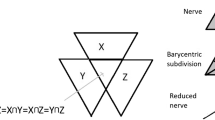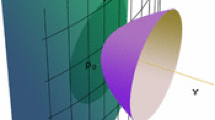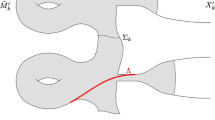Abstract
This paper extends, in a sharp way, the famous Efimov’s Theorem to immersed ends in \(\mathbb {R}^3\). More precisely, let M be a non-compact connected surface with compact boundary. Then there is no complete isometric immersion of M into \(\mathbb {R}^3\) satisfying that \(\int _M |K|=+\infty \) and \(K\le -\kappa <0\), where \(\kappa \) is a positive constant and K is the Gaussian curvature of M. In particular Efimov’s Theorem holds for complete Hadamard immersed surfaces, whose Gaussian curvature K is bounded away from zero outside a compact set.
Similar content being viewed by others
References
Bieberbach, L.: Hilberts Satz über Flächen konstanter negativer Krümmung. Acta Math. 48, 319–327 (1926)
Blanusa, D.: Über die Einbettung hyperbolischer Räume in euklidische Räume. Mon. Math. 59, 217–229 (1955)
Blaschke, W.: Vorlesungen über Differentialgeometrie, p. 206. Springer, Berlin (1924)
Cheeger, J., Gromoll, D.: On the structure of complete manifolds of nonnegative curvature. Ann. Math. 96(3), 413–443 (1972)
Cohn-Vossen, S.: Bendability of surfaces in the large. Uspekhi Mat. Nauk 1, 33–76 (1936). (Russian)
Efimov, V.: Generation of singularities on surfaces of negative curvature. Mat. Sbornik 64, 286–320 (1964). (Russian)
Gálvez, J.A., Martínez, A., Teruel, J.L.: Complete surfaces with ends of non positive curvature. arXiv:1405.0851
Hilbert, D.: Ueber Flächen von constanter Gausscher Krümmung. Math. Sot. 2, 87–99 (1901)
Holmgren, E.: Sur les surfaces à courbure constante negative. C. R. Acad. Sci. Paris 134, 740–743 (1902)
Kuiper, N.: On \(C^1\)-isometric imbeddings I, II, Nederl. Akad. Wetensch. Proc. Ser. A 58 Indig. Math. 17, 545–556 and 683–689 (1955)
Milnor, T.K.: Efimov’s theorem about complete immersed surfaces of negative curvature. Adv. Math. 8, 474–543 (1972)
Myers, S.B.: Riemannian manifolds with positive mean curvature. Duke Math. J. 8, 401–404 (1941)
Rozendorn, È.R.: A realization of the metric \(ds^2=du^2+f^2(u)\) in a five-dimensional Euclidean space. Akad. Nauk Armjan. SSR Dokl. 30, 197–199 (1960) (Russian. Armenian summary)
Smyth, B., Xavier, F.: Efimov’s theorem in dimension greater than two. Invent. Math. 90, 443–450 (1987)
Acknowledgements
The author would like to thank Heudson Mirandola, Cristina Levina and Manolo Heredia for useful discussions during the reading of [11]. He also thanks the referee for very interesting observations.
Author information
Authors and Affiliations
Corresponding author
Additional information
To my beloved wife, Cristina, whose love and sincerity inspire me.
Appendix: Proof of Lemma 3.1
Appendix: Proof of Lemma 3.1
Consider a Riemannian smooth surface (S, g) and a connected surface with piecewise smooth boundary \(D\subset S\), with internal angles at the vertices different from 0 and \(2\pi \). Denote by \(d_g(p,q)\) the distance induced by the Riemannian metric g, and \(d_{\mathrm {int}}(p,q)\) the infimum of the g-lengths of piecewise \(C^1\) curves \(\gamma :[0,1]\rightarrow D\) joining p to q satisfying that \(\gamma \bigl ((0,1)\bigr )\subset \mathrm {int}(D)\).
The purpose of this appendix is to prove Lemma 3.1 above, which asserts that \(d_\mathrm {int}\) is a distance on D, and that the distances \(d_g\) and \(d_\mathrm {int}\) induce the same topology on D.
To prove Lemma 3.1 we first assume that \(d_\mathrm {int}\) is a distance on D. To show that \(d_g\) and \(d_\mathrm {int}\) induce the same topology on D, we need to prove that, given \(q\in D\) and \(\epsilon >0\), there exists \(\delta >0\) such that if \(p\in D\) with \(d_g(p,q)<\delta \) then \(d_\mathrm {int}(p,q)<\epsilon \). If \(q\in \mathrm {int}(D)\) the proof is trivial. Thus we will assume that \(q\in \partial D\).
Fix \(q\in \partial D\) and \(\epsilon >0\). For some small \(\lambda >0\), there exists a curve \(\sigma :[-\lambda ,\lambda ]\rightarrow \partial D, \lambda >0\), parameterized by the g-arc length satisfying that \(\sigma (0)=q\) and such that \(\sigma |_{[-\lambda ,0]}\) and \(\sigma |_{[0,\lambda ]}\) are smooth curves. Since \(\partial D\) is a piecewise smooth curve and the angles at the vertices differ from 0 and \(2\pi \), there exists a unit vector \(v\in T_qS\) pointing to \(\mathrm {int}(D)\) and transversal to both \(\sigma '(0-)\) and \(\sigma '(0+)\). Let \(v_t\) be the parallel transport of v along the both directions on \(\sigma \). If \(\lambda \) is small enough, we may assume that \(v_t\) is transversal to \(\sigma '(t)\) and that \(v_t\) points to \(\mathrm {int}(D)\). Set \(\sigma _s(t)=\exp _{\sigma (t)}sv_t=\gamma _t(s)\). By smoothness of the geodesic flow there exists sufficiently small \(0<\eta <\min \left\rbrace \lambda ,\frac{\epsilon }{3}\right\lbrace \) such that:
-
(1)
for \(0<s\le \eta \) and \(-\eta \le t\le \eta \), the point \(\sigma _s(t)\in \mathrm {int}(D)\);
-
(2)
\(L_g(\sigma _\eta )<\frac{\epsilon }{3}\).
Given \(s_0\in [0,\eta ]\) and \(t_0\in [-\eta ,\eta ]\), we have that \(2\eta +|t_0|-s_0> \eta +|t_0|-s_0\ge 0\). We will construct a piecewise smooth curve \(\xi =\xi _{s_0t_0}:[0,2\eta +|t_0|-s_0]\rightarrow D\) from q to \(\sigma _{s_0}(t_0)\) satisfying \(\xi \bigl ((0,2\eta +|t_0|-s_0)\bigr )\subset \mathrm {int}(D)\) and \(L_g(\xi )<\epsilon \). From q to \(\sigma _{\eta }(0)=\gamma _0(\eta )\), let \(\xi |_{[0,\eta ]}\) coincide with the geodesic \(\gamma _0:[0,\eta ]\rightarrow D\). From \(\sigma _{\eta }(0)\) to \(\sigma _{\eta }(t_0)\) the curve \(\xi \) follows the curve \(\sigma _\eta \) in the direction that t is increasing if \(t_0\ge 0\), or in the other direction if \(t_0<0\). More precisely, for \(0\le t\le |t_0|\), we define \(\xi (\eta +t)=\sigma _\eta (t)\), if \(t_0\ge 0\), and \(\xi (\eta +t)=\sigma _\eta (-t)\), if \(t_0<0\). Finally, from \(\sigma _{\eta }(t_0)\) to \(\sigma _{s_0}(t_0)\) the curve \(\xi \) follows the geodesic \(s\longmapsto \gamma _{t_0}(\eta -s)\). Namely, for \(0\le s\le \eta -s_0\) we define \(\xi (\eta +|t_0|+s)=\gamma _{t_0}(\eta -s)=\sigma _{(\eta -s)}(t_0)\). In particular we have that \(\xi (2\eta +|t_0|-s_0)= \xi (\eta +|t_0|+(\eta -s_0))=\gamma _{t_0}(s_0)=\sigma _{s_0}(t_0)\). By construction we have that \(L_g(\xi )\le \eta + L_g(\sigma _{\eta })+(\eta -s_0)<\epsilon \).
Given \(s_1\in [0,\eta ]\) and \(t_1\in [-\eta ,\eta ]\), a similar construction as above shows that \(\sigma _{s_0}(t_0)\) may be connected to \(\sigma _{s_1}(t_1)\) by a piecewise smooth curve \(\psi :[0,1]\rightarrow D\) with \(\psi ((0,1))\subset \mathrm {int}(D)\) and \(L_g(\psi ) <\epsilon \).
Set \(X=\{\sigma _s(t)\bigm |0\le s\le \eta ,\, -\eta \le t\le \eta \}\). Since X is a compact neighborhood of q in D, we have that \(\delta =d_g(q,D-X)>0\). Now we take \(p\in D\) with \(d_g(p,q)<\delta \). We have that \(p\in X\), hence \(p=\sigma _{s_0}(t_0)\) for some \(s_0\in [0,\eta ]\) and \(t_0\in [-\eta ,\eta ]\). As a consequence we have that \(d_{\mathrm {int}}(p,q)\le L_g(\xi _{s_0t_0})<\epsilon \).
Now we consider points \(p,q,r\in D\) and we will show that \(d_\mathrm {int}(p,q)+d_\mathrm {int}(q,r) \ge d_\mathrm {int}(p,r)\). We will just consider the case that \(q\in \partial D\), since the other case is easier. Fix \(\epsilon >0\) and consider piecewise smooth curves \(\gamma :[0,1]\rightarrow D\) from p to q with \(\gamma ((0,1))\subset \mathrm {int}(D)\) and \(L_g(\gamma )<d_\mathrm {int}(p,q)+\epsilon \), and \(\sigma :[0,1]\rightarrow D\) from q to r with \(\sigma ((0,1))\subset \mathrm {int}(D)\) and \(L_g(\sigma )<d_\mathrm {int}(q,r)+\epsilon \). By using a neighborhood X of q as above, it is easy to obtain a piecewise smooth curve \(\varphi :[0,1]\rightarrow D\) from p to r with \(\varphi ((0,1))\subset \mathrm {int}(D)\) and \(L_g(\varphi )<L_g(\gamma )+L_g(\sigma )+\epsilon \). In fact, take \(0<s_1<1\) such that \(\gamma (s_1)\in X-\{q\}\) and \(0<s_2<1\) such that \(\sigma (s_2)\in X-\{q\}\). We define a curve \(\varphi \) which follows \(\gamma \) from \(t=0\) to \(t=s_1\) then follows a curve \(\psi \) in \(X\cap \mathrm {int}(D)\) with \(L_g(\psi )<\epsilon \), and then follows \(\sigma \) from \(t=s_2\) to \(t=1\). Thus we obtain that \(d_{\mathrm {int}}(p,r)\le L_g(\varphi )< L_g(\gamma )+L_g(\sigma )+\epsilon < d_\mathrm {int}(p,q)+d_\mathrm {int}(q,r)+3\epsilon \). By making \(\epsilon \rightarrow 0\) we conclude the proof of Lemma 3.1.
Remark 2
It is not difficult to see that Lemma 3.1 may be improved to assume that internal angles are just different from 0.
Remark 3
We inform that the paper [GMT] proves Theorem A, with another proof, simultaneously and independently.
Rights and permissions
About this article
Cite this article
Mendonça, S. Complete negatively curved immersed ends in \(\mathbb {R}^3\) . Geom Dedicata 195, 319–337 (2018). https://doi.org/10.1007/s10711-017-0292-3
Received:
Accepted:
Published:
Issue Date:
DOI: https://doi.org/10.1007/s10711-017-0292-3




